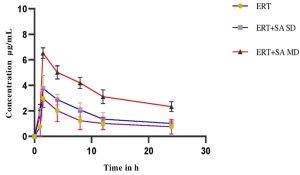
ABSTRACT
Objectives
The consumption of fruits, vegetables, dietary supplements, and herbal goods has skyrocketed, which has greatly increased human exposure to phytochemicals. Phytochemicals can alter the activity of drug-metabolizing enzyme systems such cytochrome P450, resulting in clinically significant drug-phytochemical interactions and changed plasma levels of drugs. Ertugliflozin represents a sodium-glucose co-transporter 2 inhibitor explored to treat type 2 diabetes. Sinapic acid, a bioactive phytoconstituent, treats many diseases as a dietary supplement. This study explored Sinapic acid’s effects on ertugliflozin’s pharmacodynamics as well as pharmacokinetics in Streptozotocin induced type-2 diabetic rats.
Materials and Methods
A validated RP-HPLC method was employed in order determine the ertugliflozin concentration present in the plasma samples. Ertugliflozin, both on its own and in combination with sinapic acid administered to different groups of normal rats as well as rats with diabetes that were experimentally induced and the results of the experiment concerning single dose and multiple dose interactions were analysed. In diabetic rats, the concentrations of glucose on average were measured.
Results
Ertugliflozin co-administration with sinapic acid resulted in a marginally significant increase in Cmax, t1/2, AUC, and MRT, Vd but a marginally significant decrease in CL was observed when compared to rats that were treated ertugliflozin alone. The enhancement in Cmax, AUC, t1/2, MRT, Vd and the reduction in CL may be responsible for the inhibition of CYP metabolising enzymes.
Conclusion
Intake of ertugliflozin with sinapic acid may require a minor dose adjustment, and caution should be used when the two medications are administered together for their clinical benefits in diabetic patients.
